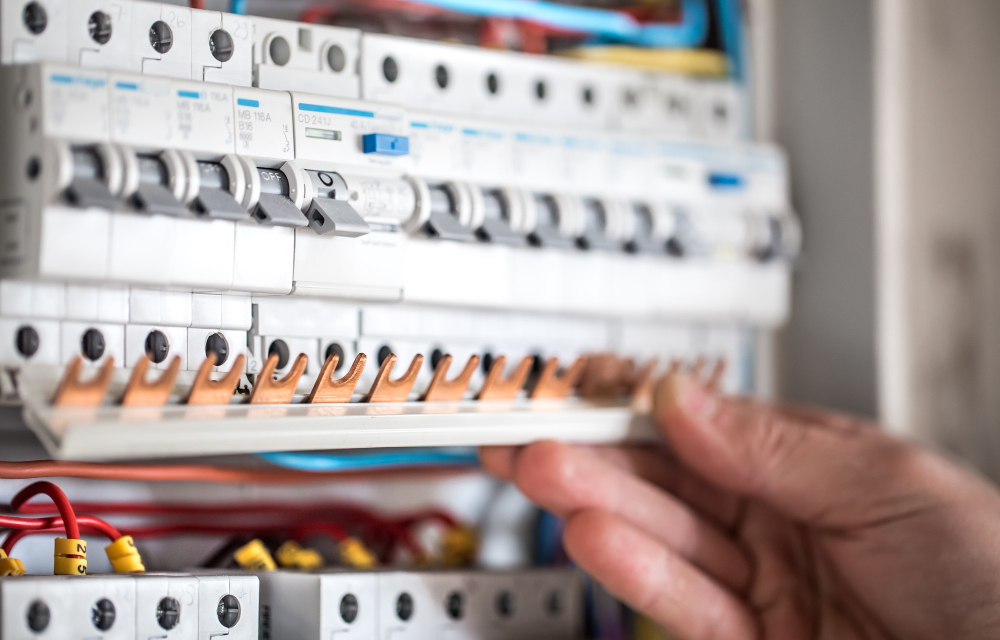Apa Itu MCB Listrik? Kenali 10 Istilah Pentingnya, Mulai dari Breaking Capacity Hingga Kurva Trip!

Apa itu MCB listrik? Anda mungkin sudah pernah mendengarnya. Benda ini hampir dapat ditemukan di setiap rumah dan berhubungan erat dengan instalasi listrik dalam bangunan. MCB merupakan alat perlindungan listrik yang sangat penting. Di dalamnya, terdapat komponen penting, termasuk banyak istilahnya yang harus kita ketahui.
Daripada penasaran, berikut penjelasan Mitra Cipta Hardi Elektrindo tentang apa itu MCB listrik dan 10 istilah penting di dalamnya, mulai dari breaking capacity hingga kurva trip, yang penting untuk dipahami. Yuk simak sampai habis artikel di bawah ini!
Baca Juga: Pengertian ELCB atau Earth-Leakage Circuit Breaker, Apa Bedanya dengan MCB?
Apa Itu MCB Listrik?
Untuk menjawab pertanyaan apa itu MCB listrik, Anda perlu berkenalan dengan perangkat kelistrikan yang satu ini. MCB merupakan singkatan dari Miniature Circuit Breaker atau pemutus sirkuit. Sama seperti namanya, alat ini digunakan untuk memutuskan jaringan listrik saat ada gangguan, seperti korsleting dan arus berlebih (overload).
MCB berbentuk saklar kecil yang dilengkapi fungsi on/off untuk menyalakan dan mematikan sambungan listrik. Cara kerjanya, apabila ada arus berlebih yang melewati sistem listrik, MCB akan segera mendeteksi gangguan tersebut dan kemudian otomatis memutuskan arus listrik dengan menurunkan saklarnya. Nantinya, saat gangguan sudah diatasi, Anda bisa kembali menyalakan listrik pada sistem dengan menaikkan saklar MCB yang tadi mengalami trip.
Pada kelistrikan rumah tangga sehari-hari, Anda mungkin pernah mengalami listrik “jeglek” atau listrik “turun”, biasanya fenomena tersebut juga berhubungan dengan fungsi MCB. Saat Anda terlalu banyak menghubungkan perangkat elektronik hingga melebihi kapasitas meteran listrik di rumah, maka sistem pun tidak sanggup menahan beban tersebut dan segera memutuskan daya listrik yang tersambung. Dengan adanya MCB, peralatan elektronik di rumah menjadi lebih aman terlindungi dari kerusakan akibat gangguan yang muncul secara tiba-tiba.
Istilah dalam MCB Listrik
Karena pentingnya MCB dalam sistem listrik, kita wajib memahami lebih mendalam tentang perangkat ini. Ada banyak hal yang perlu diketahui dari satu perangkat MCB yang terpasang di instalasi listrik rumah kita, termasuk istilah-istilah penting di dalamnya. Dengan mengetahui daftar istilah ini, Anda akan lebih menyadari betapa pentingnya MCB listrik serta dapat memilih perangkat MCB yang tepat sesuai kebutuhan.
1. Kapasitas Pemutusan Arus (Breaking Capacity)
Kapasitas pemutusan arus adalah nilai batas kemampuan MCB untuk memutuskan arus listrik saat terjadi gangguan korsleting atau overload tanpa merusak komponen internalnya. Nilai ini dinyatakan dalam kiloampere (kA) dan menentukan seberapa besar arus yang dapat dihentikan oleh MCB saat keadaan darurat.
2. Arus Pengenal (Rated Current)
Arus pengenal adalah nilai arus maksimum yang bisa dialirkan melalui MCB dalam kondisi operasi normal tanpa menyebabkan MCB trip atau putus. Arus ini biasanya dinyatakan dalam ampere (A) dan mencerminkan kapasitas nominal MCB saat bekerja pada suhu standar. Jika tiba-tiba arus listrik melebihi kapasitas rated current ini, maka saat itulah MCB akan trip.
3. Kutub (Pole/Phase)
Jumlah kutub atau pole pada MCB menunjukkan jumlah fase atau saluran yang dapat dilindungi oleh MCB tersebut. MCB bisa memiliki satu, dua, tiga, atau empat kutub (1P, 2P, 3P, dan 4P). MCB 1P biasanya digunakan untuk sistem satu fasa, sedangkan 2P, 3P, dan 4P digunakan pada sistem tiga fasa untuk memastikan proteksi arus yang lebih merata pada semua fase. Jumlah kutub ini juga dapat terlihat pada jumlah saklar di MCB.
4. Trip Level
Trip level adalah titik atau batas arus di mana MCB akan otomatis memutus arus. Tingkat trip ini dapat diatur berdasarkan jenis dan kapasitas MCB, serta dirancang untuk memutus arus pada level tertentu guna mencegah kerusakan lebih lanjut atau bahaya bagi instalasi.
5. Interrupting Capacity
Interrupting capacity mirip dengan breaking capacity, tetapi lebih spesifik pada kemampuan MCB untuk menghentikan arus pada kondisi ekstrem atau korsleting. Istilah ini sering kali digunakan dalam situasi di mana MCB harus memutus arus dalam waktu singkat untuk menghindari risiko yang lebih besar.
6. Under Trip Voltage
Under trip voltage adalah tegangan minimum di mana MCB akan trip secara otomatis. Ketika tegangan jatuh di bawah batas ini, MCB akan memutus sirkuit untuk mencegah kerusakan peralatan akibat kondisi tegangan rendah yang berkepanjangan.
7. Frekuensi
Frekuensi adalah jumlah siklus yang terjadi dalam satu detik pada arus listrik. Di Indonesia, frekuensi standar untuk arus AC adalah 50 Hz. Frekuensi ini mempengaruhi kompatibilitas MCB dengan sistem listrik yang digunakan.
8. Siklus/Durability
Siklus dapat disebut juga sebagai ukuran daya tahan MCB selama masa pakainya. Ketahanan ini diukur dalam berapa kali MCB dapat menangani kelebihan arus atau korsleting sejak dipasang. Jumlah siklus biasanya ditentukan oleh produsen MCB, misalnya pada MCB Domae dari Schneider Electric, rata-rata perangkatnya memiliki ketahanan siklus mekanis sebanyak 20.000 kali operasi dan ketahanan siklus listrik setelah 10.000 kali operasi.
9. Shunt Trip
Shunt trip adalah fitur tambahan yang memungkinkan pemutusan arus secara jarak jauh melalui sinyal eksternal. Komponen ini biasanya diaktifkan dari sistem pemantauan atau kontrol, sehingga memberikan perlindungan lebih fleksibel terutama di sistem dengan pengawasan otomatis.
10. Kurva Trip (Trip Curve)
Kurva trip atau trip curve menggambarkan respons MCB terhadap arus berlebih dalam grafik waktu terhadap arus. Kurva ini menentukan seberapa cepat MCB akan trip saat arus melebihi arus pengenal. Bisa dibilang, ini adalah "kepekaan" MCB terhadap arus berlebih. Ada beberapa jenis kurva trip MCB, di antaranya kurva B, C, dan D. MCB dengan kurva B akan memutus listrik lebih cepat saat terjadi arus lebih yang cocok untuk peralatan rumah tangga, sedangkan MCB dengan kurva C responsnya agak lebih lambat dan biasanya digunakan untuk alat yang membutuhkan arus tinggi sebentar, seperti lampu atau alat kantor.
Pentingnya Mengenal Apa Itu MCB Listrik dan Istilahnya
Apa itu MCB listrik, Anda mungkin bisa menjawabnya dengan tepat sekarang. Perlu diketahui, daftar istilah yang digunakan pada MCB yang telah dijelaskan di atas berlaku juga secara umum pada perangkat pemutus arus sirkuit (circuit breaker) yang lain, seperti MCCB, RCB, RCBO, ELCB, dan lainnya. Hal ini wajar mengingat fungsi pada pemutus arus hampir sama, meskipun ada sedikit perbedaan di antara jenis-jenis circuit breaker tersebut.
Daftar istilah di atas juga perlu Anda ketahui saat akan memasang MCB di rumah. Hal ini karena pemasangan MCB disesuaikan dengan kebutuhan instalasi listrik Anda. Mulai dari berapa kapasitas pemutusan arusnya, kurva apa yang sesuai dengan jaringan listrik Anda, hingga berapa arus pengenal MCB yang Anda butuhkan, semua itu harus ditentukan sebelum Anda membeli dan memasang MCB.
Setelah mengetahui apa itu MCB listrik dan istilahnya, kini saatnya Anda mencari tempat yang tepat untuk mendapatkan perangkat MCB atau pemutus arus lainnya dengan kualitas yang terpercaya, asli, dan bergaransi resmi. Solusi yang Anda butuhkan adalah Mitra Cipta Hardi Elektrindo dan Hokione.id, distributor alat elektrikal dan mekanikal nomor satu di Indonesia yang menyediakan kebutuhan listrik terlengkap.
Powered by Froala Editor

Powered by Froala Editor
Related News



